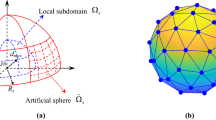Abstract
The nodal relocation method (r-method) is used to uniformly distribute element discretization errors over an analytic model and improve the solution quality. When this r-method is performed with Zienkiewicz-Zhu’s error estimator, its converged solution can not be easily obtained without many iterative calculations. Further, this method also may deteriorate solution quality because of serious element distortion. This paper suggests a new error estimator which can evaluate the size and the distortion error of an isoparametric element separately and proposes a modified r-method based on this error estimator. Various numerical experiments show that the proposed error estimator properly evaluates the element discretization errors and the modified r-method can be easily applied to the practical analysis owing to the comparatively fast convergent characteristics.
Similar content being viewed by others
References
Babuśka, I., Zienkiewicz, O. C., Gago, J. and Oliveira, E. R., 1986,Accuracy Estimates and Adaptive Refinements in Finite Element Computations, Wiley.
Cook, R. D., Malkus, D. S. and Plesha, M. E., 1989,Concepts and Applications of Finite Element Analysis, 3rd edn, Wiley.
Diaz, A. R., Kikuchi, N., Papalambros, P. and Taylor, J. E., 1983, “Design of an Optimal Grid for Finite Element Methods,”J. Struct. Mech., Vol. 11, No. 2, pp. 215–230.
Diaz, A. R., Kikuchi, N. and Taylor, J. E., 1983, “A method of Grid Optimization for Finite Element Methods,”Comput. Methods Appl. Meth. Eng., Vol. 41, pp. 29–45.
Kikuchi, N., 1986, “Adaptive Grid-Design Methods for Finite Element Analysis,”Comput. Methods Appl. Mech. Eng., Vol. 55, pp. 129–160.
Lee, N. S. and Bathe, K. J., 1993, “Effects on Element Distortions on the Performance of Isoparametric Elements,”Int. J. Numer. Methods Eng., Vol. 36, pp. 3553–3576.
Martinez, R. and Samartin, A., 1991, “Two-Dimensional Mesh Optimization in the Finite Element Method,”Comp. Struct., Vol. 40, No. 5, pp. 1169–1175.
McNeice, G. M. and Marcal, P. V., 1973, “Optimization of Finite Element Grids Based on Minimum Potential Energy”,J. Indust., ASME, pp. 186–190.
Noor, A. K., Babuśka, I., 1987, “Quality Assessment and Control of Finite Element Solutions,”Finite Element in Analysis and Design, Vol. 3, pp. 1–26.
Shephard, M. S., Gallagher, R. H. and Abel, J. F., 1980, “The Synthesis of Near-Optimum Finite Element Meshes with Interactive Computer Graphics,”Int. J. Numer. Methods Eng., Vol. 15, pp. 1021–1039.
Turche, D. J., 1976, “On Optimum Finite Element Grid Configurations,”AIAA J., Vol. 14, No. 2, pp. 264–265.
Turche, D. J. and McNeice, G. M., 1974, “Guldeline for Selecting Finite Element Grids Based on an Optimization Study,”Comp. Struct., Vol. 4, pp. 499–519.
Zienkiewicz, O. C. and Taylor, R. L., 1989,The Finite Element Method-Basic Formulation and Linear Problems, 4th edn, McGraw-Hill.
Zienkiewicz, O. C. and Zhu, J. Z., 1987, “A Simple Error Estimator and Adaptive Procedure for Practical Engineering Analysis,”Int. J. Numer. Methods Eng., Vol. 24, pp. 337–357.
Author information
Authors and Affiliations
Rights and permissions
About this article
Cite this article
Oh, H.S., Lim, J.K. Modified r-method for the finite element adaptive analysis of plane elastic problems. KSME Journal 10, 190–202 (1996). https://doi.org/10.1007/BF02953658
Received:
Issue Date:
DOI: https://doi.org/10.1007/BF02953658




